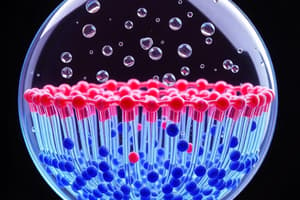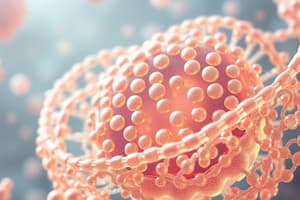Podcast
Questions and Answers
What is the primary component that constitutes the mass of the cell membrane?
What is the primary component that constitutes the mass of the cell membrane?
- Nucleic acids
- Lipids (correct)
- Carbohydrates
- Proteins
What function does the cell membrane serve in biological systems?
What function does the cell membrane serve in biological systems?
- It acts as a barrier to proteins.
- It serves as a physical and electrical barrier. (correct)
- It stores genetic information.
- It facilitates enzymatic reactions.
Which of the following statements about the cell membrane is not true?
Which of the following statements about the cell membrane is not true?
- It plays a crucial role in cellular communication.
- It contributes to the cell's structural integrity.
- It is composed of a variety of lipids.
- It is solely made of phospholipids. (correct)
Which authors provided an integrated approach to human physiology relevant to cell membranes?
Which authors provided an integrated approach to human physiology relevant to cell membranes?
In which year was 'Cell Biology by the Numbers' published?
In which year was 'Cell Biology by the Numbers' published?
What characterizes the head of a phospholipid?
What characterizes the head of a phospholipid?
What is the primary role of the hydrophobic tail in phospholipids?
What is the primary role of the hydrophobic tail in phospholipids?
How many types of phospholipids are typically found in biological membranes?
How many types of phospholipids are typically found in biological membranes?
What characteristic do more than 50% of fatty acids in membranes have?
What characteristic do more than 50% of fatty acids in membranes have?
What was significant about the use of RBCs in Gorter and Grendel's 1925 study?
What was significant about the use of RBCs in Gorter and Grendel's 1925 study?
What is the primary function of the cell membrane?
What is the primary function of the cell membrane?
Which of the following describes passive simple diffusion?
Which of the following describes passive simple diffusion?
Which mechanism of membrane transport does not require energy?
Which mechanism of membrane transport does not require energy?
What role do lipid bilayers play in cellular function?
What role do lipid bilayers play in cellular function?
What is one of the key functions of membrane transport mechanisms?
What is one of the key functions of membrane transport mechanisms?
Which of the following is NOT a basic mechanism of crossing membranes?
Which of the following is NOT a basic mechanism of crossing membranes?
How do cells regulate the concentrations of ions inside them?
How do cells regulate the concentrations of ions inside them?
What is the typical direction of solute movement in passive transport mechanisms?
What is the typical direction of solute movement in passive transport mechanisms?
What effect does a double bond between carbon atoms have on a hydrocarbon chain?
What effect does a double bond between carbon atoms have on a hydrocarbon chain?
How does the length of hydrocarbon chains in the lipid bilayer affect its characteristics?
How does the length of hydrocarbon chains in the lipid bilayer affect its characteristics?
What would be the expected effect of having shorter hydrocarbon tails in a lipid bilayer?
What would be the expected effect of having shorter hydrocarbon tails in a lipid bilayer?
What is the impact of having all hydrocarbon tails in a lipid bilayer be unsaturated?
What is the impact of having all hydrocarbon tails in a lipid bilayer be unsaturated?
Which factor contributes to the permeability of the lipid bilayer?
Which factor contributes to the permeability of the lipid bilayer?
What occurs to membrane fluidity with longer hydrocarbon tails?
What occurs to membrane fluidity with longer hydrocarbon tails?
What is the primary effect of unsaturation in hydrocarbon chains on lipid bilayers?
What is the primary effect of unsaturation in hydrocarbon chains on lipid bilayers?
How do the characteristics of lipid molecules influence the overall structure of the lipid bilayer?
How do the characteristics of lipid molecules influence the overall structure of the lipid bilayer?
Which phospholipid is characterized by having a smaller polar head and a conical shape?
Which phospholipid is characterized by having a smaller polar head and a conical shape?
What is a characteristic of phosphoglycerides in mammalian membranes?
What is a characteristic of phosphoglycerides in mammalian membranes?
Which one of the following phospholipids contributes to a flat monolayer structure?
Which one of the following phospholipids contributes to a flat monolayer structure?
Which lipid would likely be found in the membranes of organisms adapted to cold environments?
Which lipid would likely be found in the membranes of organisms adapted to cold environments?
What role does the lipid distribution in eukaryotic membranes play?
What role does the lipid distribution in eukaryotic membranes play?
Which of the following statements is true about sphingomyelin?
Which of the following statements is true about sphingomyelin?
Which phospholipid is not part of the phosphoglyceride class?
Which phospholipid is not part of the phosphoglyceride class?
What characteristic primarily differentiates cardiolipin from other phospholipids?
What characteristic primarily differentiates cardiolipin from other phospholipids?
The term 'lipid bilayer' primarily refers to which aspect of membrane structure?
The term 'lipid bilayer' primarily refers to which aspect of membrane structure?
Which type of lipid is primarily responsible for cell signaling in animal membranes?
Which type of lipid is primarily responsible for cell signaling in animal membranes?
Flashcards are hidden until you start studying
Study Notes
Cell Membrane Composition
- Cell membranes are primarily composed of lipids, with phospholipids being the most abundant.
- Phospholipids contain a hydrophilic head and a hydrophobic tail.
- The hydrophilic head faces the water-side of the lipid bilayer, while the hydrophobic tail aligns in the middle of the bilayer.
- More than 50% of fatty acids in membranes have one or more double bonds.
- Membranes contain over 100 types of phospholipids.
Lipid Bilayer Structure
- Gorter and Grendel (1925) determined the structure of the lipid bilayer, showing that it is a double layer of phospholipids.
- The structure of the lipid bilayer is determined by the properties of its lipid molecules:
- The number of double bonds in hydrocarbon tails impacts fluidity, with double bonds creating "kinks" and increasing fluidity.
- The length of hydrocarbon tails affects fluidity and permeability, shorter chains leading to increased fluidity and permeability.
Major Phospholipids in Mammalian Plasma Membranes
- The predominant phospholipids in mammalian cell membranes include Phosphatidyl-inositol (PI), Phosphatidyl-ethanolamine (PE), Phosphatidyl-serine (PS), Phosphatidyl-choline (PC), and Sphingomyelin (SM).
- Phospholipids are classified based on their head group - the molecule attached to the phosphate group.
- Each phospholipid has a different shape:
- PI has an inverted conical shape.
- PE has a smaller polar head and a conical shape.
- PS and PC have cylindrical shapes, forming a flat monolayer.
Lipids Distribution in Eukaryote Membranes
- Eukaryote membranes have a diverse lipid composition, with varying ratios of different phospholipids.
- The distribution of lipids can affect the physical state of the membrane and influence the activity of membrane proteins.
- PC: Phosphatidylcholine
- PS: Phosphatidylserine
- PE: Phosphatidylethanolamine
- PI: Phosphatydilinositol
- SM: Sphingomyelin
- ISL: Inositol sphingolipid
- CL: Cardiolipin
- MBP: Bis monoacylglycerol phosphate
Cell Membrane as a Barrier
- The cell membrane acts as a barrier that regulates the movement of substances across the membrane.
- It controls the entry of ions and nutrients into the cell, the elimination of cellular wastes, and the release of products from the cell.
Membrane Transport
- The lipid bilayer of the cell membrane maintains concentration gradients for solutes, creating differences between the cytosol and extracellular fluid.
- Cells have evolved to transfer specific water-soluble molecules and ions across their membranes, facilitating nutrient uptake, waste excretion, and ion regulation.
Mechanisms of Crossing the Membrane
- Solutes can cross the cell membrane through four main mechanisms:
- Passive-Simple diffusion: Always from high to low concentration.
- Facilitated diffusion
- Active transport
- Vesicular transport
- Each mechanism handles different molecules and contributes to maintaining cellular homeostasis.
Studying That Suits You
Use AI to generate personalized quizzes and flashcards to suit your learning preferences.




